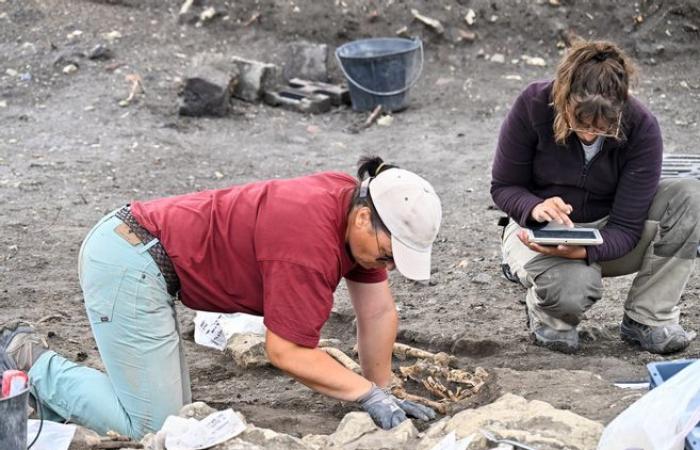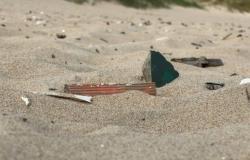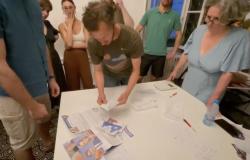Unveil the past of Place des Carmes. This is the challenge that archaeologists, anthropologists and other experts are leading on site until November.
Uncovering the remains of the past to learn as much as possible about those who came before us, before they disappear. This is the objective of the preventive archaeology mission launched at Place des Carmes, in Clermont-Ferrand. Many elements discovered already tell us more about those who lived here hundreds of years ago.
In the middle of the excavation site, a Gallo-Roman wall adjoined by scraps of walls, probably medieval, serves as an illustration for Jérôme Besson, archaeologist and operation manager, attached to Archeodunum SAS:
There is a tangle of structures from different periods. Our job is to untangle all that, understand these arrangements, what we did here
City or countryside?
A work which is a continuation of 2019, where a first phase led to asking this question: “Are we still in the ancient city of Carmes or are we in the countryside? ?? The limit is in this sector.” Excavations reveal a density of structures. “We are therefore in an area peripheral to the city, but clearly laid out. At the moment, we cannot answer with certainty. Were people more oriented towards agriculture or towards urban life? »
Middle Ages
In the Middle Ages, the Carmes area tended towards rural areas, between the towns of Clermont and Montferrand. It was marked by the presence of religious buildings, notably the abbey of Chantoin. This medieval occupation, which is currently being unearthed, shows that we are here around the 12th century, with certainly fragments of buildings and particularly silos. These large pear-shaped holes dug in the ground were used to store crops.
“We have a silage area, with a good fifteen, even twenty silos. There will be more as we research. They are perhaps related to the presence of this congregation. Are these silage structures linked to the presence of a convent or abbey, or rather linked to the mills which were there to process the crops and which lined the course of the Tiretaine? It must in fact have passed a few hundred meters,” asks Jérôme Besson.
Receive our leisure newsletter by email and find ideas for outings and activities in your region.
Burials
A little further on the site, two colleagues of the operation manager are engaged in meticulous work uncovering graves. We’ll have to wait until we clear the walls and see what’s underneath to be able to date them. The bones will be studied, in particular by one of his colleagues, an anthropologist, who will look into the care given to these burials and date them.
We will have to see how the bodies decomposed: in clothes, in shrouds, in the ground, in a coffin, etc. A paleopathologist colleague will also be able to identify if there have been diseases or trauma.
Fragments d’os
In several areas of the excavation, teams discovered a multitude of small bone fragments. “Perhaps someone worked on (animal) bone, to make pins, hinges for small chests… We might be able to prove the presence of a tablet maker’s workshop here. These bones, gleaned throughout the excavation, will also allow us to know what we ate at the time. »
The same with the diversity of shards, with here a remains of a jug, there serving crockery with the sigillae (of Lezoux), there rather beautiful varnished crockery produced in the Allier valley. The numerous pottery shards will be recovered to obtain dating elements. “Dishware has evolved according to fashion,” says Jérôme Besson.
premium What archaeologists discovered on the site of the ancient Saint-Genès church in Clermont-Ferrand
There are around ten of them searching at Carmes. The team will strengthen in the coming weeks to explore these 3,200 m². Time is counted.
A little further still, under the viaduct, the remains are just beginning to emerge. Particularly those of a Gallo-Roman terracotta pipe. We are also on a possible path. Many questions remain unanswered. Experts have until November to find out as much as possible.
A project in three phases
The work began with stripping on May 13, Place des Carmes. The excavation team arrived two weeks later. The first phase will continue until mid-summer. “We are going to refill, then strip the area located under the viaduct,” indicates Jérôme Besson.
premium The last mysteries of the basements of the Hôtel-Dieu in Clermont-Ferrand
The second phase will begin in the fall. During the third, the teams will monitor the network burying work planned on rue du Souvenir français. Field work will last until early November. “Afterwards, we have two years of study involving a procession of specialists and experts. »
Text: Gaëlle Chazal
Photos : Thierry Lindauer






